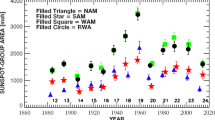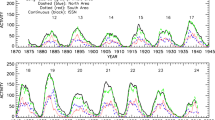Abstract
There exists a small but statistically significant north–south asymmetry in most of the solar activity indices and it has important implications on the solar dynamo mechanism. Here we analyzed the daily sunspot-group data reported by the Greenwich Photoheliographic Results (GPR) during the period 1874–1976, Debrecen Photoheligraphic Data (DPD) during the period 1977–2017, and the revised Version-2 of international sunspot number (ISSN) during the period 1874–2017. We determined the amplitudes (the largest 13-month smoothed monthly ISSN) of Solar Cycles 12–24 and the 13-month smoothed monthly mean corrected areas of the sunspot groups in the Sun’s whole-sphere (WSGA), northern hemisphere (NSGA), and southern hemisphere (SSGA) at the epochs of the maxima of Solar Cycles 12–24. Using all these we obtained the relations similar to that found in our earlier analyzes–i.e. the existence of a high correlation between the sum of the areas of sunspot groups in the southern-hemisphere near-equatorial band during a small (7–9 months) interval just after a maximum epoch of a solar cycle and the amplitude of next solar cycle–separately for the Sun’s whole-sphere and northern- and southern-hemispheres. By using these relations we predict ≈701 msh (millionth of solar hemisphere), ≈429 msh, and ≈366 msh for the values of WSGA, NSGA, and SSGA, respectively, at the maximum epoch of Solar Cycle 25. We predict \(86 \pm 18\) for the amplitude of Solar Cycle 25. The 13-month smoothed monthly mean sunspot-group area highly correlate with that of ISSN. Using this relation and the predicted values of WSGA, NSGA, and SSGA we obtain \(68 \pm 11\) for the amplitude of Solar Cycle 25, which is slightly lower than the aforementioned predicted value, and \(39 \pm 4\) and \(31 \pm 6\) for the values of northern- and southern-hemispheres’ sunspot numbers at the maximum epoch of Solar Cycle 25. The difference between the predicted NSGA and SSGA and also that between northern- and southern-hemispheres’ sunspot numbers at the maximum epoch of Solar Cycle 25 are considerably small. Overall, our results suggest that the amplitude of Solar Cycle 25 would be 25%–40% smaller, and the corresponding north–south asymmetry would be much smaller, than those of Solar Cycle 24.











Similar content being viewed by others
References
Badalyan, O.G., Obridko, V.N.: Astron. Astrophys. 603, A109 (2017)
Baranyi, T., Győri, L., Ludmány, A.: Sol. Phys. 291, 3081 (2016)
Belucz, B., Dikpati, M.: Astrophys. J. 779, 4 (2013)
Bhowmik, P., Nandy, D.: Nat. Commun. 9, A5209 (2018)
Cameron, R.H., Jian, J., Schüssler, M., Gizon, L.: J. Geophys. Res. 119, 680 (2014)
Cameron, R.H., Jiang, J., Schüssler, M.: Astrophys. J. Lett. 823, 122 (2016)
Carbonell, M., Oliver, R., Ballester, J.L.: Astron. Astrophys. 274, 497 (1993)
Chowdhury, P., Choudhary, D.P., Gosain, S.: Astrophys. J. 768, 188 (2013)
Chowdhury, P., Gokhale, M.H., Singh, J., Moon, Y.-J.: Astrophys. Space Sci. 361, 54 (2016)
Clette, F., Lefévre, L.: Sol. Phys. 291, 2629 (2016)
Covas, E., Peixinho, N., Fernandes, J.: Sol. Phys. 294, 24 (2019)
Deng, L.H., Xiang, Y.Y., Qu, Z.N., An, J.M.: Astrophys. J. 151, 700 (2016)
Dikpati, M., Gilman, P.A.: Astrophys. J. 559, 428 (2001)
Dikpati, M., Gilman, P.A.: Astrophys. J. 649, 498 (2006)
Dikpati, M., Gilman, P., de Toma, G., Ghosh, S.: Sol. Phys. 245, 1 (2007)
Dikpati, M., Gilman, P.A., de Toma, G.: Astrophys. J. Lett. 673, 99 (2008)
Du, Z.L.: Astrophys. J. 132, 1485 (2006)
Duchlev, P.I., Dermendjiev, V.N.: Sol. Phys. 168, 205 (1996)
Goel, A., Choudhuri, A.: Res. Astron. Astrophys. 9, 115 (2009)
Gopalswamy, N., Mäkelä, P., Yashiro, S., Akiyama, S.: J. Atmos. Sol.-Terr. Phys. 176, 26 (2018)
Győri, L., Baranyi, T., Ludmány, A.: Proc. Intern. Astron. Union 6, Symp. S273, 403 (2010). https://doi.org/10.1017/s174392131101564X
Győri, L., Ludmány, A., Baranyi, T.: Mon. Not. R. Astron. Soc. 465, 1259 (2017)
Hathaway, D.H.: Living Rev. Sol. Phys. 12(4), 1 (2015)
Hathaway, D.H., Choudhary, D.P.: Sol. Phys. 250, 269 (2008)
Hathaway, D.H., Upton, L.A.: J. Geophys. Res. 121, 10744 (2016)
Hathaway, D.H., Wilson, R.M., Reichmann, E.J.: Sol. Phys. 211, 357 (2002)
Hawkes, G., Berger, M.A.: Sol. Phys. 293, 109 (2018)
Helal, H.R., Galal, A.A.: J. Advert. Res. 4, 275 (2012)
Javaraiah, J.: Mon. Not. R. Astron. Soc. 377, L34 (2007)
Javaraiah, J.: Sol. Phys. 252, 419 (2008)
Javaraiah, J.: New Astron. 34, 54 (2015)
Javaraiah, J.: Sol. Phys. 292, 172 (2017)
Javaraiah, J.: In: D. Banerjee, J. Jiang, K. Kusano, and S. Solanki (eds.) Long-term datasets for the Understanding of Solar and Stellar Magnetic Cycles. Proc. Intern. Astron. Union Symp. 340 (2018). https://doi.org/10.1017/s174392131800131X
Javaraiah, J.: Sol. Phys. 294, 64 (2019)
Javaraiah, J.: Sol. Phys. 295, 8 (2020)
Javaraiah, J., Gokhale, M.H.: Sol. Phys. 170, 389 (1997)
Javaraiah, J., Bertello, L., Ulrich, R.: Sol. Phys. 232, 25 (2005)
Jiang, J., Cao, J.: J. Atmos. Sol.-Terr. Phys. 176, 34 (2017)
Jiang, J., Chatterjee, P., Choudhuri, A.R.: Mon. Not. R. Astron. Soc. 381, 1527 (2007)
Jiang, J., Wang, J.X., Jiao, Q.R., Cao, J.B.: Astrophys. J. 863, 159 (2018)
Kitiashvili, I.N.: Astrophys. J. 890, 36 (2020)
Knaack, R., Stenflo, J.O., Berdyugina, S.V.: Astron. Astrophys. 418, L17 (2004)
Labonville, F., Charbonneau, P., Lemerle, A.: Sol. Phys. 294, 82 (2019)
Mandal, S., Banerjee, D.: Astrophys. J. Lett. 830, L33 (2016)
McIntosh, S.W., Leamon, R.J., Gurman, J.B., et al.: Astrophys. J. 765, 146 (2013)
Miao, J., Wang, X., Ren, T.-L., Li, Z.-T.: Res. Astron. Astrophys. 20, 4 (2020)
Muraközy, J.: Sol. Phys. 294, 46 (2019)
Muraközy, J., Ludmány, A.: Mon. Not. R. Astron. Soc. 419, 3624 (2012)
Nepomnyashchikh, A., Mandal, S., Banerjee, D., Kitchatinov, L.: Astron. Astrophys. 625, A37 (2019)
Norton, A.A., Gallagher, J.C.: Sol. Phys. 261, 193 (2010)
Norton, A.A., Charbonneau, P., Passos, D.: Space Sci. Rev. 186, 251 (2014)
Okoh, D.I., Seemala, G.K., Rabiu, A.B., Uwamahoro, J.B., Habarulema, J.B., Aggarwal, M.: Space Weather 16, 1424 (2018)
Pesnell, W.D.: Space Weather 16, 1997 (2018)
Pesnell, W.D., Schatten, K.H.: Sol. Phys. 293, 112 (2018).
Pishkalo, M.I.: Sol. Phys. 294, 137 (2019)
Ravindra, B., Javaraiah, J.: New Astron. 39, 55 (2015)
Sarp, V., Kilcik, A., Yurchyshyn, V.B., Rozelot, J.P., Ozguc, A.: Mon. Not. R. Astron. Soc. 481, 2981 (2018)
Schüssler, M., Cameron, R.H.: Astron. Astrophys. 618, A89 (2018)
Shetye, J., Tripathi, D., Dikpati, M.: Astrophys. J. 799, 220 (2015)
Singh, A.K., Bhargawa, A.: Astrophys. Space Sci. 362, 199 (2017)
Sokoloff, D., Nesme-Ribes, E.: Astron. Astrophys. 288, 293 (1994)
Svalgaard, L., Kamide, Y.: Astrophys. J. 763, 23 (2013)
Upton, L.A., Hathaway, D.H.: Geophys. Res. Lett. 45, 8091 (2018)
Verma, V.K.: Astrophys. J. 403, 797 (1993)
Vizoso, G., Ballester, J.L.: Astron. Astrophys. 229, 540 (1990)
Volobuev, D.M., Makarenko, N.G.: Sol. Phys. 292, 68 (2017)
Wang, Y.-M.: Space Sci. Rev. 210, 351 (2017)
Zolotova, N.V., Ponyavin, D.I., Arlt, R., Tuominen, I.: Astron. Nachr. 331, 765 (2010)
Acknowledgements
The author thanks the anonymous referees of both the first and the revised versions of the manuscript for useful comments and suggestions. The author acknowledges the work of all the people contribute and maintain the GPR and DPD Sunspot databases. The sunspot-number data are provided by WDC-SILSO, Royal Observatory of Belgium, Brussels.
Author information
Authors and Affiliations
Corresponding author
Additional information
Publisher’s Note
Springer Nature remains neutral with regard to jurisdictional claims in published maps and institutional affiliations.
Formerly with Indian Institute of Astrophysics, Bengaluru-560 034, India
Rights and permissions
About this article
Cite this article
Javaraiah, J. North–south asymmetry in solar activity and Solar Cycle prediction, V: prediction for the north–south asymmetry in the amplitude of Solar Cycle 25. Astrophys Space Sci 366, 16 (2021). https://doi.org/10.1007/s10509-021-03922-w
Received:
Accepted:
Published:
DOI: https://doi.org/10.1007/s10509-021-03922-w




